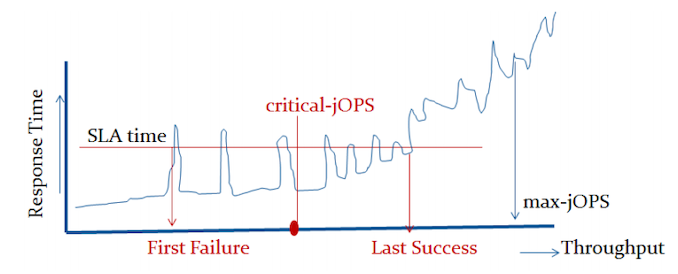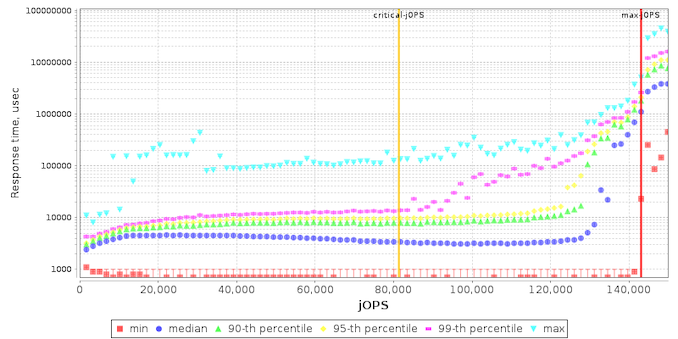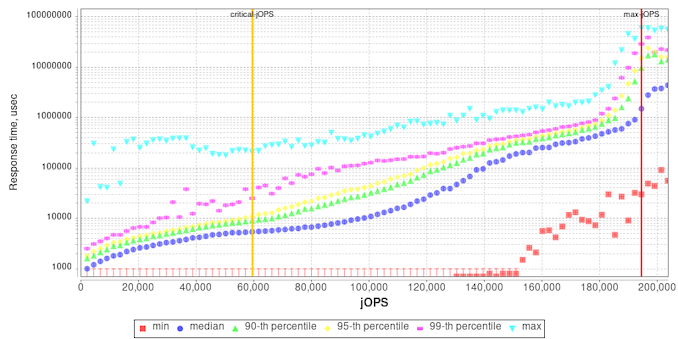The Ampere Altra Review: 2x 80 Cores Arm Server Performance Monster
by Andrei Frumusanu on December 18, 2020 6:00 AM EST- Posted in
- Servers
- Neoverse N1
- Ampere
- Altra
SPECjbb MultiJVM - Java Performance
Moving on from SPECCPU, we shift over to SPECjbb2015. SPECjbb is a from ground-up developed benchmark that aims to cover both Java performance and server-like workloads, from the SPEC website:
“The SPECjbb2015 benchmark is based on the usage model of a worldwide supermarket company with an IT infrastructure that handles a mix of point-of-sale requests, online purchases, and data-mining operations. It exercises Java 7 and higher features, using the latest data formats (XML), communication using compression, and secure messaging.
Performance metrics are provided for both pure throughput and critical throughput under service-level agreements (SLAs), with response times ranging from 10 to 100 milliseconds.”
The important thing to note here is that the workload is of a transactional nature that mostly works on the data-plane, between different Java virtual machines, and thus threads.
We’re using the MultiJVM test method where as all the benchmark components, meaning controller, server and client virtual machines are running on the same physical machine.
The JVM runtime we’re using is OpenJDK 15 on both x86 and Arm platforms, although not exactly the same sub-version, but closest we could get:
Altra system:
openjdk 15.0.1 2020-10-20
OpenJDK Runtime Environment 20.9 (build 15.0.1+9)
OpenJDK 64-Bit Server VM 20.9 (build 15.0.1+9, mixed mode, sharing)
EPYC & Xeon systems:
openjdk 15 2020-09-15
OpenJDK Runtime Environment (build 15+36-Ubuntu-1)
OpenJDK 64-Bit Server VM (build 15+36-Ubuntu-1, mixed mode, sharing)
Furthermore, we’re configuring SPECjbb’s runtime settings with the following configurables:
SPEC_OPTS_C="-Dspecjbb.group.count=$GROUP_COUNT -Dspecjbb.txi.pergroup.count=$TI_JVM_COUNT -Dspecjbb.forkjoin.workers=N -Dspecjbb.forkjoin.workers.Tier1=N -Dspecjbb.forkjoin.workers.Tier2=1 -Dspecjbb.forkjoin.workers.Tier3=16"
Where N=160 for 2S Altra test runs, N=80 for 1S Altra test runs, N=112 for 2S Xeon, N=56 for 1S Xeon, and N=128 for 2S and 1S on the EPYC system. I tried running 256 or 160 threads on the 2S EPYC configuration but the benchmark would error out with a critical timeout and I wasn’t able to fully debug as to why it did that.
In terms of JVM options, we’re limiting ourselves to bare-bone options to keep things simple and straightforward:
Altra & EPYC system:
JAVA_OPTS_C="-server -Xms2g -Xmx2g -Xmn1536m"
JAVA_OPTS_TI="-server -Xms2g -Xmx2g -Xmn1536m"
JAVA_OPTS_BE="-server -Xms48g -Xmx48g -Xmn42g -XX:+AlwaysPreTouch"
Xeon system:
JAVA_OPTS_C="-server -Xms2g -Xmx2g -Xmn1536m"
JAVA_OPTS_TI="-server -Xms2g -Xmx2g -Xmn1536m"
JAVA_OPTS_BE="-server -Xms172g -Xmx172g -Xmn156g -XX:+AlwaysPreTouch"
The reason the Xeon system is running a larger back-end heap is because we’re running a single NUMA node per socket, while for the Altra and EPYC we’re running four NUMA nodes per socket for maximised throughput, meaning for the 2S figures we have 8 backends running for the Altra and EPYC and 2 for the Xeon, and naturally half of those numbers for the 1S benchmarks. The back-ends and transaction injectors are affinitised to their local NUMA node with numactl –cpunodebind and –membind, while the controller is called with –interleave=all.
The max-jOPS and critical-jOPS result figures are defined as follows:
"The max-jOPS is the last successful injection rate before the first failing injection rate where the reattempt also fails. For example, if during the RT-curve phase the injection rate of 80000 passes, but the next injection rate of 90000 fails on two successive attempts, then the max-jOPS would be 80000."
"The overall critical-jOPS is computed by taking the geomean of the individual critical-jOPS computed at these five SLA points, namely:
• Critical-jOPSoverall = Geo-mean of (critical-jOPS@ 10ms, 25ms, 50ms, 75ms and 100ms response time SLAs)
During the RT curve building phase the Transaction Injector measures the 99th percentile response times at each step level for all the requests (see section 9) that are considered in the metrics computations. It then computes the Critical-jOPS for each of the above five SLA points using the following formula:
(first * nOver + last * nUnder) / (nOver + nUnder) "

That’s a lot of technicalities to explain an admittedly complex benchmark, but the gist of it is that max-jOPS represents the maximum transaction throughput of a system until further requests fail, and critical-jOPS is an aggregate geomean transaction throughput within several levels of guaranteed response times, essentially different levels of quality of service.
Beyond the result figures, the benchmark keeps detailed track of timings of responses and tracks a few important statistical data-points across a response-time curve, as follows:
I’m starting off with the EPYC results as they’re sort of standard – the max-jOPS here ends up quite high at over 270k, while the critical-jOPS ends up around 125k. The system still manages to retain 90th percentile response times under 20ms up until 230k which is excellent, with 99th percentile results starting to degrade after 110k jOPS.
On the Xeon system, we see similar flat 90th percentile response times up until around 120k with 99th percentiles starting to degrade following 90k, but in a much tighter curve than on the EPYC system – while the system here has less overall throughput its scaling up to that throughput limit could be considered to be better.
With the EPYC and Xeon systems as context, we’re finally looking at the Altra results, which look very different.
Unlike the x86 systems, 99th and 90th percentile response times degrade earlier on in the throughput curve for the Altra chip. What this actually reminded me of is the STREAM results from earlier in the review where we saw that initially a bunch of cores were able to hit peak bandwidth across the memory controllers, but adding further cores to the mix actually degraded performance, pointing out to suboptimal congestion across the mesh interconnect.
It might be possible that the results here across SPECjbb are hitting a similar level of saturation under load, given that there’s a lot of inter-core communication and memory transactions happening.

Charting the max-jOPS of the different systems, I ran figures for both 1S and 2S system configurations. Additionally, I also tested out the benchmark both with transparent huge pages always enabled, and to a default not used / madvise state, as we’ve seen in the past that this can have a notable impact on the resulting performance.
Whilst the Altra system is able to beat the Xeon, it’s not sufficient to match the EPYC system which still lies considerably ahead by a good margin. The exact reasons for this discrepancy compared to the x86 systems isn’t immediately clear, as we’re dealing with many layers here. AArch64 OpenJDK JVM performance certainly might not be as mature and optimised as the x86-64 counterparts, and there is certainly a rabbit hole of various optimisations and knobs we could have tried to change things – although we still view these simple default out-of-the-box settings to still be valuable and valid in terms of comparisons.
One thing that did come to mind immediately when I saw the results was SMT. Due to this being a transactional data-plane resident type of workload, SMT will undoubtedly help a lot in terms of performance, so I tested out the EPYC chip figures with SMT disabled, and indeed max-jOPS went down to 209.5k for the 2S THP enabled results, meaning that SMT accounts for a 29.7% performance benefit in this benchmark.
A further indication that the Altra system is being underutilised on the part of the cores and memory-bottlenecked is its power consumption, which even when fully loaded in the RT curve, it generally hovered around 170-180W per socket, while the x86 systems were filling up their TDPs.
It’s generally these kinds of workloads that SMT works best on, and that’s why IBM can deploy SMT4 or SMT8 processors, and the type of workloads Marvell’s ThunderX was trying to carve a niche or itself with SMT4.

For the critical-jOPS figures, the Altra doesn’t do well at all given its response-time curve. Beyond the lack of SMT (The EPYC here again achieves its high score through a 26.4% contribution of the secondary logical cores), we’re maybe looking at a software side immaturity of out-of-the-box Java performance on Arm systems. The figures here shouldn’t be taken with absolute authority with a conclusion that Java performance on the Altra sucks, but at least we’re seeing signs that it doesn’t look too great.













148 Comments
View All Comments
mode_13h - Thursday, December 31, 2020 - link
Isn't Blender included in SPECfp2017 as 526.blender_r? Or is that something different?Teckk - Friday, December 18, 2020 - link
Whoever decided on naming these products — fantastic job. Simple, clear and effective.Maybe you can offer some free advice to Intel and Sony.
Calin - Friday, December 18, 2020 - link
The answer to the question of "how powerful it is" is clear - more than good enough.The real question in fact is:
"How much can they produce?"
AMD has the crown in x86 processor performance, but this doesn't really matter very much as long as they can build enough processors only for a part of the market.
jwittich - Friday, December 18, 2020 - link
How many do you need? :)Bigos - Friday, December 18, 2020 - link
64kB pages might significantly enhance performance on workload with large memory sets, as the TLB will be up to 16x less used. On the other hand, memory usage of the Linux file system cache will also increase a lot.Would you be able to test the effect of 64kB vs 4kB page size on at least some workloads?
Andrei Frumusanu - Friday, December 18, 2020 - link
It's something that I wanted to test but it requires a OS reinstall / kernel recompile - I didn't want to get into that rabbit hole of a time sink as already spent a lot of time verifying a lot of data across the three platforms over a few weeks already.arnd - Friday, December 18, 2020 - link
I'd love to see that as well. For workloads that use transparent huge pages, there should not be much difference since both would use 2MB huge pages (512*4KB or 32*64KB), plus one or more even larger page sizes, but it needs to be measured to beThe downsides of 64KB requiring larger disk I/O and more RAM are often harder to quantify, as most benchmarks try to avoid the interesting cases.
I've tried benchmarking kernel compiles on Graviton2 both ways and found 64kB pages to be a few percent faster when there is enough RAM, but forcing the system to swap by limiting the total RAM made the 64kB kernel easily 10x to 1000x slower than the 4kB one, depending on the how the available memory lined up with the working set.
abufrejoval - Friday, December 18, 2020 - link
Thank you for the incredible amount of information and the work you put into this: Anandtech's best!Yet I wonder who would deploy this and where. The purchasing price of the CPU would seem to become a rather miniscule part of the total system cost, especially once you go into big RAM territory. And I wonder if it's not similar with the energy budget: I see my larger systems requiring more $ and Watts on RAM than on the CPUs. Are they doing, can they do anything there to reduce DRAM energy consumption vs. Intel/AMD?
The cost of the ecosystem change to ARM may be less relevant once you have the scale to pay for it, but where exactly would those scale benefits come from? And what scales are we talking about? Would you need 100k or 1m servers to break even?
And what sort of system load would you have to reach/maintain to have significant energy advantages vs. x86 iron?
Do they support special tricks like powering down quadrants and RAM banks for load management, do they enable quick standby/actvation modes so that servers can be take off and on for load management?
And how long would the benefits last? AMD has demonstrated rather well, that the ability to execute over at least three generations of hardware are required to shift attention even from the big guys and they have still all the scaling benefits the x86 installed base provides.
These guys are on a 2nd generation product, promise 3rd but essentially this would seem to have the same level of confidence as the 1st EPIC.
askar - Friday, December 18, 2020 - link
Would you mind testing ML performance, i.e. python's SKLearn library classes that can be multithreaded (random forest for example)?mode_13h - Sunday, December 20, 2020 - link
MLPerf?